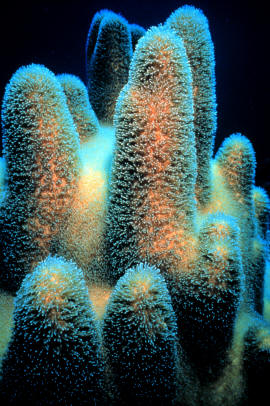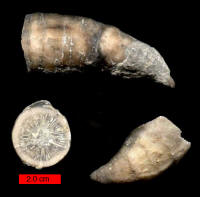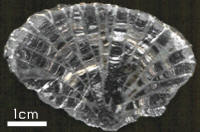The Rugosa, also called the
Tetracoralla, are
an extinct
order of
coral that were
abundant inMiddle
Ordovician to Late
Permian seas.
Solitary rugosans (e.g.,
Caninia,
Lophophyllidium,
Neozaphrentis,
Streptelasma) are
often referred to as horn corals
because of a unique horn-shaped chamber with a wrinkled, or
rugose, wall. Some
solitary rugosans reached nearly a meter in length. However, some species of
rugose corals could form large colonies (e.g.,
Lithostrotion). When
radiating septa were present, they were usually in multiples of four.
Rugose corals have a skeleton made
of
calcite that is often
fossilized. Like modern corals (Scleractinia),
rugose corals were invariably
benthic, living on
the sea floor or in a reef-framework. Although there is no direct proof, it
is inferred that these
Palaeozoic corals
possessed stinging cells to capture prey. They also had tentacles to help
them catch prey. Technically they were carnivores, but prey-size was so
small they are often referred to as microcarnivores.
Rugose corals became dominant by
the middle of the Silurian period, and became extinct early in the
Triassic period. The
Rugose corals existed in solitary and colonial forms, and are also composed
of calcite.
Tabulate Corals
The
tabulate corals, forming the
order Tabulata,
are an
extinct form of
coral. They are
almost always
colonial, forming
colonies of individual
hexagonal cells known
as
corallites defined by
a
skeleton of
calcite, similar in
appearance to a
honeycomb. Adjacent
cells are joined by small pores. Their distinguishing feature is their
well-developed horizontal internal partitions (tabulae)
within each cell, but reduced or absent vertical internal partitions (septae).
They are usually smaller than
rugose corals, but
vary considerably in shape, from flat to conical to spherical.
Around 300 species have been
described. Among the most common tabulate corals in the
fossil record are
Chaetetes,
Favosites,
Halysites,
Heliolites,
Pleurodictyum,
Sarcinula and
Syringopora.
Like rugose corals, they lived
entirely during the
Paleozoic, being
found from the
Ordovician to the
Permian. With
Stromatoporoidea and
rugose corals, the tabulate corals are characteristic of the shallow waters
of the
Silurian to the
Devonian. Sea levels
rose in the Devonian, and tabulate corals became much less common. They
finally became extinct in the
Permian-Triassic extinction event.
Tabulate corals occur in the
limestones and
calcareous
shales of the
Ordovician and
Silurian periods, and
often form low cushions or branching masses alongside Rugose corals. Their
numbers began to decline during the middle of the Silurian period and they
finally became extinct at the end of the
Permian period, 250
million years ago. The skeletons of Tabulate corals are composed of a form
of calcium carbonate known as
calcite.
Other Corals
The
Scleractinian corals
filled the niche vacated by the extinct Rugose and Tabulate species. Their
fossils may be found in small numbers in rocks from the Triassic period, and
become common in the
Jurassic and later
periods. Scleractinian skeletons are composed of a form of calcium carbonate
known as
aragonite. Although
they are geologically younger than the Tabulate and Rugose corals, their
aragonitic skeleton is less readily preserved, and their fossil record is
less complete.
At certain times in the geological
past corals were very abundant. Like modern corals, these ancestors built
reefs, some of which now lie as great structures in
sedimentary rocks.
Fossils of fellow reef-dwellers
algae, sponges, and the remains of many
echinoids,
brachiopods,
bivalves,
gastropods, and
trilobites appear
along with coral fossils. This makes some corals useful
index fossils,
enabling geologists to date the age the rocks in which they are found.
Coral fossils are not restricted to
reef remnants, and many solitary corals may be found elsewhere, such as
Cyclocyathus,
which occurs in
England's
Gault clay formation.
For more information on reefs, check out the excellent
web resource known as "The
Virtual Silurian Reef."
End of Reading

Return to the
Old Earth Ministries Online Earth
History Curriculum homepage.

Source:
Corals,
Coral Reef


